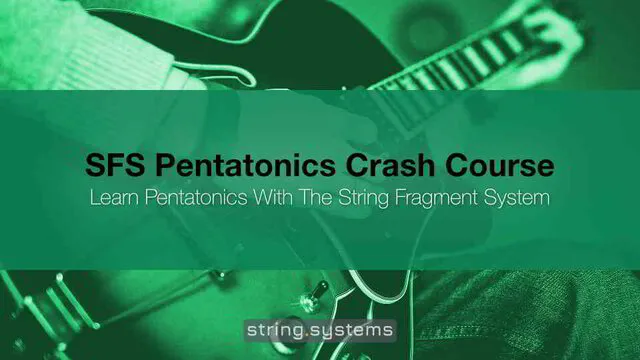How to break out of the pentatonic boxes
SFS Pentatonics Crash Course 2.0
🎁 Sign up for FREE for the complete mini-course:
🎥 Video Transcript:
Guitar players usually start their journey into improvisation and soloing by learning a pentatonic box shape. And it's exciting because the box shape is a shortcut that allows you to start soloing immediately, without really knowing anything else. Just mix these notes up and it will probably sound cool 😳.
But like with all shortcuts, the excitement soon fades out, and you start to feel "boxed in" in that scale shape that you memorized 😥.
Hey friends,
This is Prokopis from string systems, and today we’ll look at how the String Fragment System™ helps you break out of the classic pentatonic box shapes. If you like this lesson, you can get the complete mini-course for free.
So you learned the boxes, but now you feel stuck in them. What do you do?
The standard advice is usually to learn some other people's licks and play them. Now there's nothing wrong with that, ok? Looking at how other people play can be very useful.
But without some deeper understanding, you are in for a long confusing journey, and a lot of wasted time until you finally begin to actually know what you are doing.
So let’s look at how this effective method called SFS, or the String Fragment System™ works. It’s an easy system that helps you learn any type of scale faster, and move freely on the fretboard without staying stuck in scale boxes.
First of all, did you ever wonder why the 5 pentatonic boxes look different? I mean, if it's the same scale, it has the same notes, the same intervals, why don't the boxes the look same?
Well, they ARE the same. You are just looking at them the wrong way. Let’s take box 1 of A minor blues scale for example.
Next to the root note, A, there’s another note 3 frets up [example in the video]. We’ll call these two notes string “fragment” SF1. Now let’s see if we can find that string fragment in the other boxes [example in the video].
Do you see? It’s in all of them. Just on different strings. Now let’s take the next string fragment up, which we will call SF2. Now let’s play SF1 together with SF2 in all the boxes [example in the video].
Do you see? Again, it’s in all of them. Well, if I continue to do this, you will see that all 5 boxes are made from the exact same string fragments. You just need to learn how to stack them correctly.
This is the first level of the String Fragment System: Instead of memorizing the 5 different boxes, which are chunky and difficult to manipulate, you learn to jump freely to any area of the fretboard and build that scale shape in real-time.
This is so much easier than memorization, but it’s also more musical. That’s because this approach helps you understand the structure of what you are playing, it allows you to move around the fretboard and be creative, it helps you to play by ear, and so on. But we can elaborate on all this in later lessons.
For now, I’ll just give you one simple example application of this approach. I’ll play a melodic idea using just SF1 and SF2, starting on the note A. Then I will jump to other A’s around the fretboard and embellish that same idea. This is something that would work well in a solo [example in the video].
Now, if you tried to do something like this using the boxes, it would be much harder. But with SFS, even a beginner can do it.
I believe that our job as teachers is to develop practice methods that are faster and more effective than the old ones. I know that we can’t re-invent everything, and I have great respect for all the methods and teachers that helped my generation of musicians. But there’s always space for improvement. And in more than 20 years of teaching guitar, I have found that SFS has helped my students reach their soloing goals faster than any other approach.
So in the next lesson, we will take a deeper look at how we can apply this system. For now, you can look through the diagrams on this lesson page and explore how all the box shapes are constructed from the same 5 string fragments.



